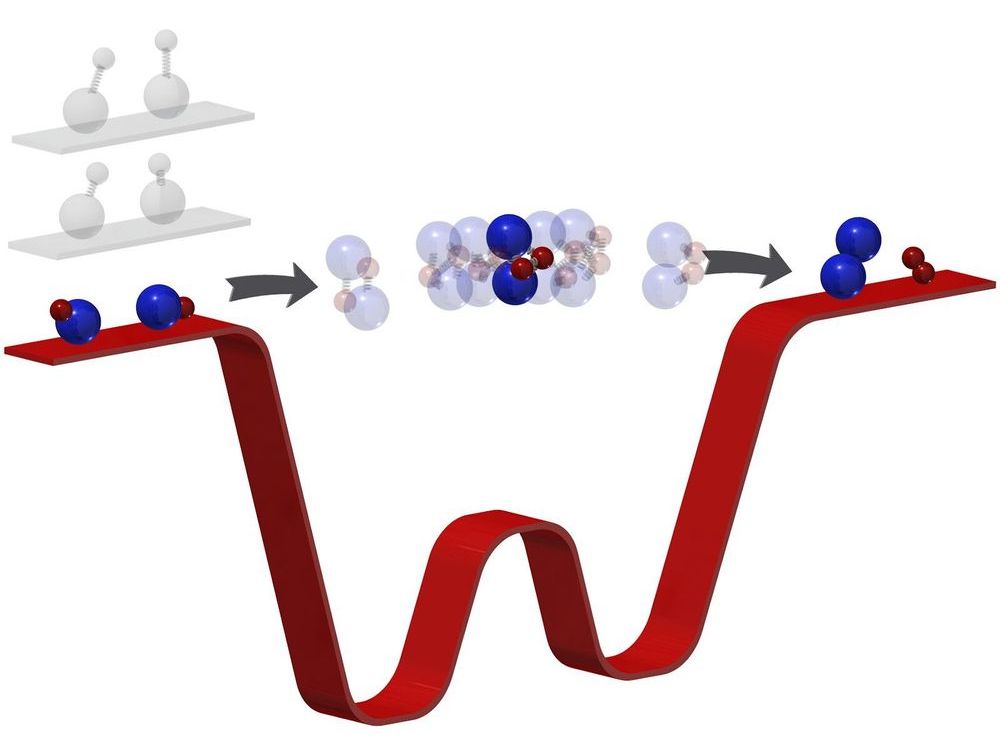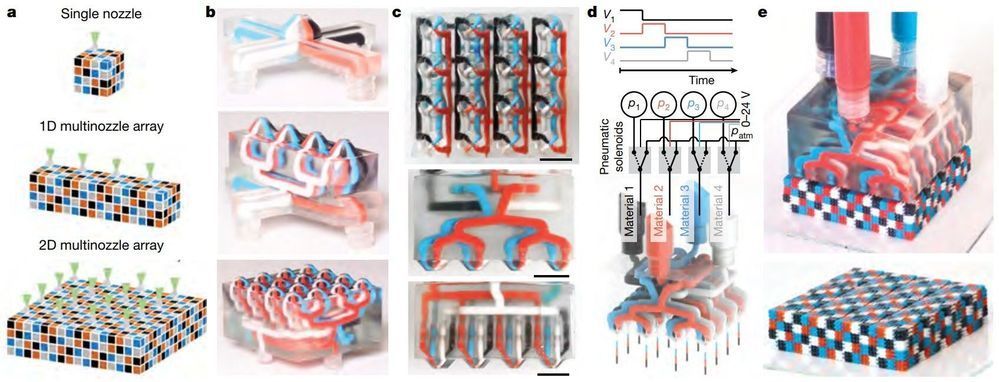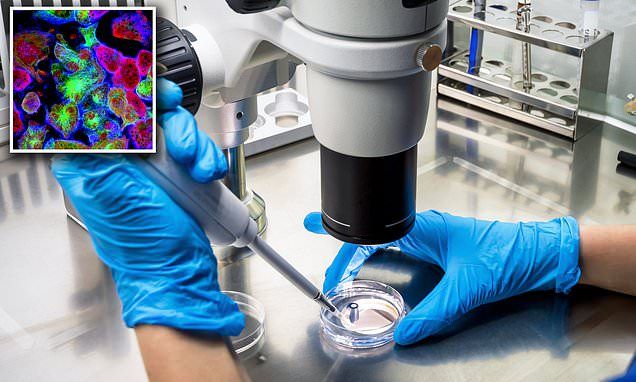Lex Fridman had a great conversation with Dr. Dava Newman, a Professor in the Department of Aeronautics and Astronautics and Engineering Systems at MIT and affiliate faculty in the Harvard-MIT Health Sciences and Technology Program, on Space Exploration, Space Suits, and Life on Mars.
Category: engineering – Page 199

With ultracold chemistry, researchers get a first look at exactly what happens during a chemical reaction
The coldest chemical reaction in the known universe took place in what appears to be a chaotic mess of lasers. The appearance deceives: Deep within that painstakingly organized chaos, in temperatures millions of times colder than interstellar space, Kang-Kuen Ni achieved a feat of precision. Forcing two ultracold molecules to meet and react, she broke and formed the coldest bonds in the history of molecular couplings.
“Probably in the next couple of years, we are the only lab that can do this,” said Ming-Guang Hu, a postdoctoral scholar in the Ni lab and first author on their paper published today in Science. Five years ago, Ni, the Morris Kahn Associate Professor of Chemistry and Chemical Biology and a pioneer of ultracold chemistry, set out to build a new apparatus that could achieve the lowest temperature chemical reactions of any currently available technology. But they couldn’t be sure their intricate engineering would work.
Now, they not only performed the coldest reaction yet, they discovered their new apparatus can do something even they did not predict. In such intense cold—500 nanokelvin or just a few millionths of a degree above absolute zero—their molecules slowed to such glacial speeds, Ni and her team could see something no one has been able to see before: the moment when two molecules meet to form two new molecules. In essence, they captured a chemical reaction in its most critical and elusive act.

Ant-based troll detection
Uncovering trolls and malicious or spammy accounts on social media is increasingly difficult as the miscreants find more and more ways to camouflage themselves as seemingly legitimate. Writing in the International Journal of Intelligent Engineering Informatics, researchers in India have developed an algorithm based on ant-colony optimization that can effectively detect accounts that represent a threat to normal users.
Asha Kumari and Balkishan Department of Computer Science and Applications at Maharshi Dayanand University, in Rohtak, India, explain that the connections between twitter users are analogous to the pheromone chemical communication between ants and this can be modeled in an algorithm based on how ant colonies behave to reveal the strongest connections in the twitter network and so uncover the accounts that one might deem as threatening to legitimate users.
The team’s tests on their system were successful in terms of precision, recall, f-measure, true-positive rate, and false-positive rate based on 26 features examined by the system played against almost 41,500 user accounts attracted to honeypots. Moreover, they report that the approach is superior to existing techniques. The team adds that they hope to be able to improve the system still further by adding so-called machine learning into the algorithm so that it can be trained to better identify threatening accounts based on data from known threats and legitimate accounts.
Ray Kurzweil (USA) at Ci2019 — The Future of Intelligence, Artificial and Natural
The Future of Intelligence, Artificial and Natural
Ray Kurzweil is one of the world’s leading inventors, thinkers, and futurists, with a thirty-year track record of accurate predictions. Called “the restless genius” by The Wall Street Journal and “the ultimate thinking machine” by Forbes magazine, he was selected as one of the top entrepreneurs by Inc. magazine, which described him as the “rightful heir to Thomas Edison.” PBS selected him as one of the “sixteen revolutionaries who made America.”
Ray was the principal inventor of the first CCD flat-bed scanner, the first omni-font optical character recognition, the first print-to-speech reading machine for the blind, the first text-to-speech synthesizer, the first music synthesizer capable of recreating the grand piano and other orchestral instruments, and the first commercially marketed large-vocabulary speech recognition.
Among Ray’s many honors, he received a Grammy Award for outstanding achievements in music technology; he is the recipient of the National Medal of Technology, was inducted into the National Inventors Hall of Fame, holds twenty-one honorary Doctorates, and honors from three U.S. presidents.
Ray has written five national best-selling books, including New York Times best sellers The Singularity Is Near (2005) and How To Create A Mind (2012). He is Co-Founder and Chancellor of Singularity University and a Director of Engineering at Google heading up a team developing machine intelligence and natural language understanding.
Ci2019 featured over 40 global leaders including Chief Technology Officer of Google Ray Kurzweil (USA), CEO of NESTA Geoff Mulgan CBE (UK), Chief Data and Transformation Officer at DBS Bank Paul Cobban (Singapore), A.I. Experts Professor Toby Walsh and Liesl Yearsley (USA), Co-founder of Oxford Insights Emma Martinho-Truswell (UK), Ethics leader Professor Simon Longstaff, Ethics and Culture of Robots and AI Professor Kathleen Richardson (UK), brain performance neuroscientist Dr Etienne Van Der Walt (South Africa), transdisciplinary Behavioural Scientist Dr Richard Claydon (Hong Kong), Director of the Learning Technology Research Centre Carl Smith (UK), Australia’s Chief Scientist Dr Alan Finkel AO, Deakin University Vice Chancellor Professor Jane Den Hollander, ATO’s Jane King, Innovation & Science Australia CEO Dr Charles Day, CEDA CEO Melinda Cilento, Jobs for NSW CEO Nicole Cook, Behaviour Innovation founder & CEO John Pickering, People and Performance expert Andrew Horsfield, TEDx Melbourne’s Jon Yeo and many more to be announced.

German robotics set to shrink for first time in decade
Germany’s prized industrial robotics and automation sector is expecting a drop in sales this year for the first time since the global financial crisis, an industry body said on Friday.
The Mechanical Engineering Industry Association (VDMA) is expecting sales to fall by five percent to 14.3 billion euros ($15.8 billion) this year.
This would be the first drop since the 32-percent plunge seen in 2009 in the wake of the crisis.

Filipina High School Student Discovered ‘Aratiles’ Fruit as Potential Cure for Diabetes, Wins Intel International Science and Engineering Fair (ISEF) in Phoenix, Arizona, USA
This 16-year-old high school student from Iloilo went viral after discovering the properties of Aratiles fruit or Sarisa that can cure diabetes.
The young Filipina scientist was identified as Maria Isabel Layson, was one of the winners of the 2019 National Science and Technology Fair (NSTF), that was held last February.
She was also one of the 12 candidates sent to the International Science and Engineering Fair in Phoenix, Arizona USA to represent the Philippines in one of the biggest pre-college science research competition in the world and was the first in her batch to receive Gokongwei Brothers Foundation Young Scientist Award.


NASA’s Helical Engine Design that Uses Closed-Cycle Propellant; A Proposed Stardrive that May Enable Interstellar Travel
Twentieth Century technology has relied on the use of fuels and chemical propellants to propel our ships, planes, and cars. The propulsion technology of the future will not use chemical combustion to produce thrust, and the 21st century will see the emergence of propellant-less propulsion systems. Such technologies will provide the means to travel faster than ever before at a fraction of current costs and with no pollution by-products.
This becomes absolutely crucial for interplanetary and interstellar travel, as we have stated before in RSF commentary1 reporting on Resonance-based technology may provide inertial mass reduction—the future of space travel will not be performed with chemical propellants. As an example, to date the most viable proposal for an interstellar mission with current technological capabilities is the Breakthrough Starshot project which will use a fleet of light sail probes propelled to 20% percent the speed of light via laser pulses.
Considering the significant limitations of combustion-based propulsion (as well as the harmful environmental impacts), there is a strong drive to develop the next-generation propulsion systems that will move us into the next phase of technological advancement. Torus Tech, a research and development company founded by Nassim Haramein, the founder of the Resonance Science Foundation, is researching quantum vacuum engineering technologies that will enable gravitational control and zero-point energy production.

Multimaterial 3D printing manufactures complex objects, fast
3D printers are revolutionizing manufacturing by allowing users to create any physical shape they can imagine on-demand. However, most commercial printers are only able to build objects from a single material at a time and inkjet printers that are capable of multimaterial printing are constrained by the physics of droplet formation. Extrusion-based 3D printing allows a broad palette of materials to be printed, but the process is extremely slow. For example, it would take roughly 10 days to build a 3D object roughly one liter in volume at the resolution of a human hair and print speed of 10 cm/s using a single-nozzle, single-material printhead. To build the same object in less than 1 day, one would need to implement a printhead with 16 nozzles printing simultaneously!
Now, a new technique called multimaterial multinozzle 3D (MM3D) printing developed at Harvard’s Wyss Institute for Biologically Inspired Engineering and John A. Paulson School of Engineering and Applied Sciences (SEAS) uses high-speed pressure valves to achieve rapid, continuous, and seamless switching between up to eight different printing materials, enabling the creation of complex shapes in a fraction of the time currently required using printheads that range from a single nozzle to large multinozzle arrays. These 3D printheads themselves are manufactured using 3D printing, enabling their rapid customization and facilitating adoption by others in the fabrication community. Each nozzle is capable of switching materials at up to 50 times per second, which is faster than the eye can see, or about as fast as a hummingbird beats its wings. The research is reported in Nature.
“When printing an object using a conventional extrusion-based 3D printer, the time required to print it scales cubically with the length of the object, because the printing nozzle has to move in three dimensions rather than just one,” said co-first author Mark Skylar-Scott, Ph.D., a Research Associate at the Wyss Institute. “MM3D’s combination of multinozzle arrays with the ability to switch between multiple inks rapidly effectively eliminates the time lost to switching printheads and helps get the scaling law down from cubic to linear, so you can print multimaterial, periodic 3D objects much more quickly.”

Breakthrough as scientists create a new cowpox-style virus that can kill EVERY type of cancer
Scientists have created a new cowpox-style virus in a bid to cure cancer.
The treatment, called CF33, can kill every type of cancer in a petrie dish and has shrunk tumours in mice, The Daily Telegraph reported.
US cancer expert Professor Yuman Fong is engineering the treatment, which is being developed by Australia biotech company Imugene.